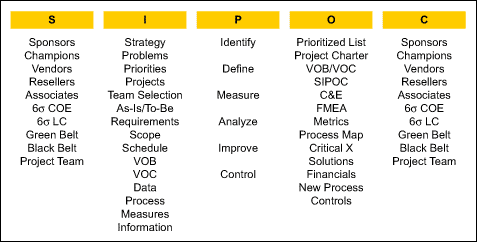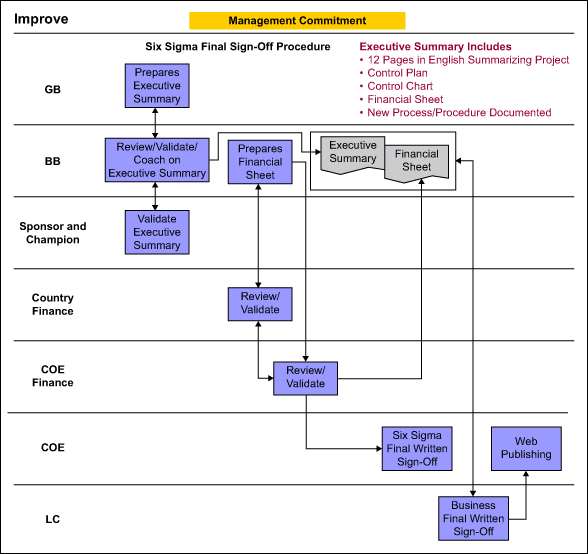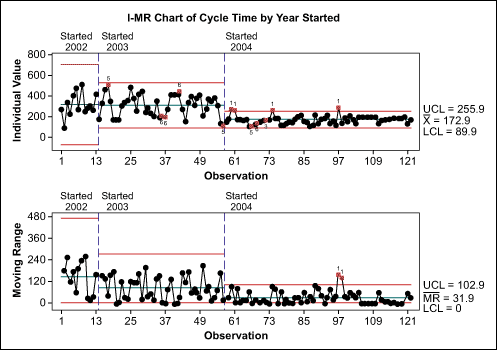
When looking at a company-wide Six Sigma program and key success factors, it is important to have not only a good strategy for deployment, but also for evaluating the results and making necessary adjustments for improvement. Development work should continue as long as the program exists. No program is ever perfect, and no program is any good unless it meets the needs of the business. Because needs change, any program must grow through evaluation and improvements.
Take this example: In 2002, through the initiative of a vice president in human resources for Europe, the fictitious company IT-R-Us started a Six Sigma program. The company had used external consultants the first year, and later hired Master Black Belts and a director of Six Sigma to oversee the program. Management had expected that the projects would deliver financial results quickly to help the businesses.
A Problem Arises
In June 2003, IT-R-Us wanted to measure the impact the Six Sigma program was having on the business after one year. It did this by looking at successful projects, defined as those completed in a timely manner with a measurable impact. Unfortunately, management was not getting the results they had expected with the Green Belts trained. Projects were delayed and there was a risk of continuing the deployment without proof of success. At that time, less than 20 percent of projects were completed in less than six months. IT-R-Us set an objective to have more than 60 percent of the projects in 2004 completed in less than six months. An innovative way to drive this change was to create a Six Sigma project to improve the company’s Six Sigma program.
Determining Project Details
The sponsor for this project was the vice president of human resources reporting to the European president. A suppliers, inputs, process, outputs, customers (SIPOC) diagram was used to scope the project, identifying the inputs and outputs and defining their stakeholders (Figure 1). An additional step, Identify, was added before Define in the typical DMAIC roadmap to allow for the selection of projects.

By examining the inputs as well as an assessment of the program’s performance, the Six Sigma team decided to focus on the Define and the Improve phases. During a Black Belt training, a Murphy’s analysis, a brainstorming tool that helps look for root causes by asking what is contributing to defects in the process, was completed. It demonstrated several key problem areas:
- Changing business needs and priorities
- Lack of Champion and sponsor support and buy-in
- Lack of measurement data
- Bad scoping of projects
In order to better understand the facts behind these initial ideas from the Black Belt coaches, a survey was conducted online. Data was collected from a total of almost 100 respondents – sponsors, Green Belts and Black Belts in the European organization. The survey was developed using a cause-and-effect diagram (Table 1).
| Table 1: Sample from Cause-and-effect Matrix | ||||||
| Metrics | On track with project schedule | 6-month duration of DMAIC (sign off to sign off) | Amount and frequency of Sponsor time | Frequency of Master Black Belt or Black Belt coaching | Business Y is business objective for 2004 | Total |
| Rating of importance to customer | 24 | 25 | 27 | 26 | 24 | |
| Define | 9 | 9 | 9 | 3 | 9 | 978 |
| Operational priorities | 9 | 9 | 9 | 9 | 9 | 1134 |
| Business objectives | 0 | 9 | 9 | 9 | 9 | 918 |
| Project goal | 3 | 9 | 9 | 3 | 9 | 834 |
| Improve | 9 | 9 | 9 | 3 | 9 | 978 |
| Financial analysis | 9 | 9 | 9 | 9 | 9 | 1134 |
| Sponsor decision | 9 | 9 | 9 | 3 | 9 | 978 |
| Identification of process weakness | 9 | 9 | 9 | 9 | 3 | 990 |
| Root cause analysis | 9 | 9 | 3 | 9 | 3 | 828 |
The DMAIC process and its inputs were listed in vertical rows of the diagram. For the customer requirements columns, the senior management team defined proper expectations and metrics. The most important expectations and metrics were:
- Are we on track with the project schedule?
- Six-month duration of DMAIC (sign off to sign off)
- Amount and frequency of time spent by the sponsor and the Green Belt on the project
- Frequency of coaching from Black Belt or Master Black Belt
- Whether Business Y was a business objective for that year
The questions for the Define phase relate to three small x’s: a) the company’s business objectives b) operational priorities and c) projects in a particular country. From these questions, the most significant results came from these areas:
- The operational, or day-to-day, priorities of the business for the respondent’s job position during the project being clear and consistent
- The operational priorities being linked to the respondent’s Six Sigma project
The questions for the Improve phase relate to four small x’s: a) identification of process weakness, b) root cause analysis, c) sponsor decision and d) financial analysis. Most respondents disagreed with the statement that “thorough financial analysis of the improvement(s) selected was made” using the company’s “financial impact guidelines.”
When the respondents were asked what suggestions could be useful for getting projects completed in a timely manner with a measurable impact, they repeated the theme of greater support and time management, along with a need for better project selection.
Solutions and Implementation
Implementation of the improvements to the program began in 2004 and focused around two themes: project management and business objectives. A project management structure was created that highlighted better expectations between management and the project teams. To meet business objectives, the team worked to gather the commitment needed to move projects forward and to ensure that the projects would be contributing to the business. Both required a review of the training curriculum and how the knowledge was deployed by the program office, the Six Sigma Center of Excellence in Europe.
In order to increase awareness of Six Sigma in the organization, more than 50 Six Sigma projects were made available on the Web; posting to the Web became a requirement for project leaders to get sign off for the tollgates. At the same time, case studies instead of generic examples were integrated in the training. Master Black Belts delivered training in the main regions, using local Black Belts and the local language. Training was followed by coaching.
Ownership of the projects and the objectives fell on the management team. The executive management team in Europe formed a Leadership Council that would set project priorities and review with project sponsors the project progress against set tollgates and the expected benefits. This review process included a formalized sign-off procedure for the different tollgates (Figure 2). The sign-off procedure involving the Master Black Belt, the Leadership Council vice president, the sponsor, the project leader and the country chief financial officer (CFO). The CFO was responsible for signing off on the benefits with regard to a budgeted objective. The Center of Excellence developed a formal process for finance, used to determine costs and benefits of the project, specifically at the Measure and Control phases. This process was validated quarterly for a period of 12 months following the project.

Finally, a dashboard was created to manage project selection and prioritization. The dashboard was the collection of metrics in use for the budgeting process, linking the key business metrics on a national, regional and European level. Six Sigma projects were focused on areas in which the business was not performing well. The dashboard also helped to determine which projects should be on a country level and which could be European wide, benefiting multiple businesses.
Moving Forward on Target
The results were significant and created a large interest in supporting and participating in the program. Sponsors said that they better understood what Six Sigma could do to help them meet their business targets, and that they were better prepared to select projects. Every month, to create a sense of ownership, country managers and sponsors participated in teleconferences explaining the status of their projects and any deviations from plan. No manager wanted to explain to a vice president why a project was behind schedule or budget, which helped to ensure that the right projects and project leaders were selected and that the support given, in terms of resources and time allocated, was appropriate.
There was also a visible effect on project completion (Figure 3).

The original target of 60 percent of projects finishing in six months or less was achieved in 2004. That year the business contribution doubled compared to the previous year with the same number of projects.